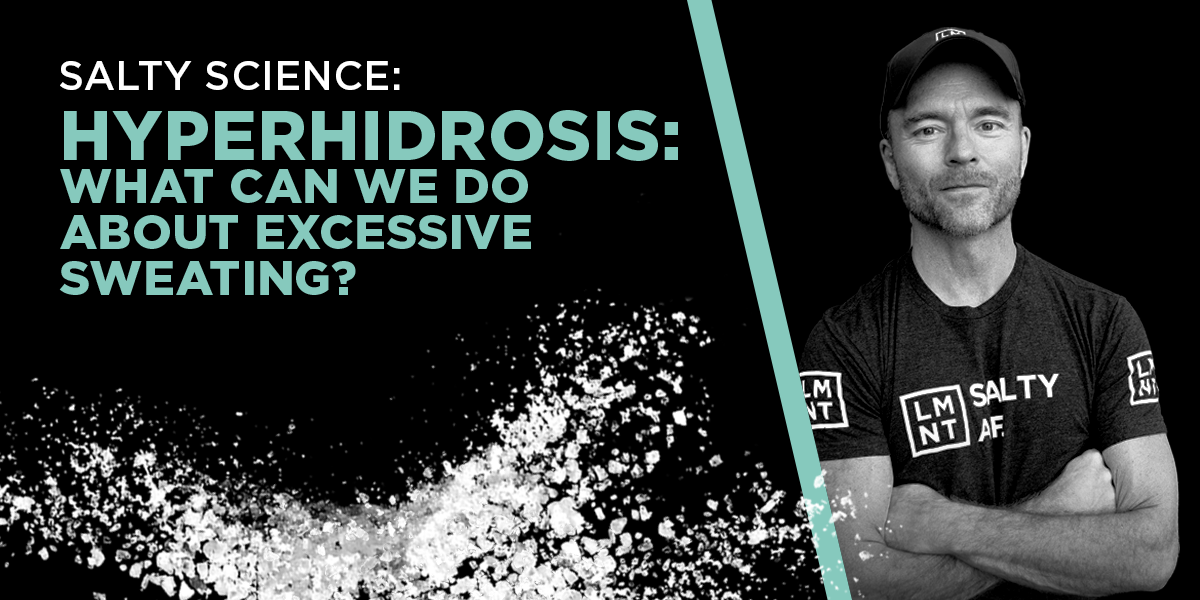About 3% of people suffer from a frustrating condition called hyperhidrosis. People with hyperhidrosis sweat excessively, even in cool environments.
Hyperhidrosis can be life-altering. Moist handshakes, clothes soaked with perspiration, skin more prone to infections—all these situations can create anxiety and embarrassment.
For instance, teens with hyperhidrosis are often scared to raise their hands or go on a date. Others might layer on clothes or constantly change outfits to hide the sweat. Can you imagine preparing for a job interview with this condition? Many people have.
Hyperhidrosis doesn’t just affect a person’s sense of well being. Excessive sweat loss means excessive fluid and sodium loss, so timely hydration is paramount to prevent fatigue, muscle cramps, weakness, brain fog, and other symptoms. Folks with hyperhidrosis must rehydrate much like an athlete jogging through the jungle. I’ll share practical hydration tips in a bit.
Treating hyperhidrosis depends on the person and the cause of the sweating. I’ll review treatment options later so you can make better decisions with your medical provider. I’ll also review the symptoms, causes, and diagnostic criteria for hyperhidrosis. Let’s get started
What Is Hyperhidrosis?
Hyperhidrosis is a condition of excessive sweating due to overstimulation of the sweat glands. Hyper means excessive, and hidrosis means sweating. When someone has hyperhidrosis, they sweat when their body is otherwise cool.
The primary function of sweat is to prevent overheating. Even mildly elevated core body temperature can disrupt basic bodily processes, lead to heat stroke, and potentially be fatal. Sweat prevents this from happening.
With hyperhidrosis, this system is partly broken. You sweat when you’re hot, but you also sweat when you’re cool.
The unwanted sweat usually pops up on the palms, forehead, underarms, and/or feet. For example, the hands and forehead may get soaked while the rest of the body stays dry, or sweaty underarms may spur frequent wardrobe changes.
Hyperhidrosis sounds like a benign condition. It’s just sweat, right? But the truth is that excessive sweating can be detrimental to one’s quality of life in many ways, if only just for comfort reasons.
Let’s talk more about hyperhidrosis symptoms now.
Symptoms of Hyperhidrosis
The symptoms of hyperhidrosis include:
- Noticeable sweating. Are you sweating at rest? Are your clothes getting soaked while sitting? Is your forehead beading up in a cool room?
- Impaired routine activities. Does the moisture make it difficult to hold a writing utensil or grip a gaming controller?
- Wet skin. Is your skin constantly wet, causing softness and peeling?
- Skin infections. Are you getting jock itch, athlete’s foot, or other skin infections in areas of heavy sweating?
If you have some of these symptoms, it may be worth seeing a dermatologist to investigate whether hyperhidrosis is the cause. Other causes, such as simply living in a hot or humid environment, are important to consider because all of the symptoms above are multifactorial.
Primary vs. Secondary Hyperhidrosis
There are two main types of hyperhidrosis. Primary hyperhidrosis means excessive sweating with no identifiable cause. Secondary hyperhidrosis means that a “secondary” cause (usually a medication or medical condition) is to blame.
Primary hyperhidrosis usually begins in childhood and involves excessive sweating in a specific body part (forehead, palms, etc.) at least once per week. The sweating may begin upon waking, independent of room temperature.
People with secondary hyperhidrosis are more likely to have whole body sweats and night sweats. Causes of secondary hyperhidrosis include:
- Medications like antidepressants, antipsychotics, and insulin
- Medical conditions like hyperthyroidism, diabetes, Parkinson’s disease, gout, frostbite, obesity, physical injury, tumors, and menopause
If you can pinpoint the cause of the excessive sweating, you can take steps to remedy it. But this isn’t so easy with primary hyperhidrosis.
What Causes Primary Hyperhidrosis?
Researchers aren’t sure what causes primary hyperhidrosis. It likely involves genetic, hereditary factors, but the underlying pathology is poorly understood.
Hyperhidrosis is associated with sympathetic, “fight or flight,” nervous system arousal. This arousal causes excessive release of a chemical called acetylcholine, which tells the hypothalamus to activate the sweat response. Acetylcholine also acts on sweat glands directly, telling them to get to work.
The key term here is excessive. Some acetylcholine is healthy and normal, but too much of this chemical drives hyperhidrosis.
Who Gets Hyperhidrosis?
About 3% of people have hyperhidrosis. Most of these people fall between the ages of 20 and 60, and there are no observed differences between men and women. Japanese people are more likely to have hyperhidrosis than other ethnicities.
Primary hyperhidrosis usually starts early in life. If excessive sweating starts in adulthood, however, you’re probably looking at secondary hyperhidrosis.
Diagnosing Hyperhidrosis
If a patient presents with excessive sweating, the doctor must determine whether it’s primary or secondary hyperhidrosis. This determination will inform the subsequent treatment strategy.
Here are the diagnostic criteria and risk factors for primary hyperhidrosis:
- Excessive sweating symptoms for six months or more
- Sweating episodes lasting 1+ week(s)
- Sweating in the palms, face, feet, or armpits
- Sweating on both sides of the body (i.e., both palms or armpits)
- Less sweating at night
- Being 25 or younger
- Having a family history of hyperhidrosis
- Sweating that affects one’s daily life
If the clinician suspects a secondary cause, the doctor may order lab work to rule out kidney disease, infection, cancer, diabetes, and other conditions linked to excessive sweating. This lab work may include:
- Blood count
- Metabolic panel
- Thyroid hormone panel
- Hemoglobin A1C test
- Chest x-ray
A doctor will also review your medications because many can cause excessive sweating. The cure may be as simple as switching drugs. We cannot stress this strongly enough, however… do not ever change medication regimen without a discussion with your prescribing physician and securing their OK to do so.
Treatments for Hyperhidrosis
Usually, doctors’ first-recommended treatments for hyperhidrosis include aluminum-based antiperspirants. These topical agents suppress sweating in the soles, feet, and elsewhere. The downsides are that they can be irritating, the effects aren’t everlasting, and aluminum—in specific body tissues, at high enough concentrations—is a well-documented neurotoxin.
If topicals don’t work, doctors may prescribe anticholinergic drugs to block acetylcholine from stimulating sweat glands. Side effects include constipation, dry mouth, dry eyes, and decreased urinary volume.
Iontophoresis, another treatment, entails sending a gentle electrical current into shallow water pans and through your skin (your hands and feet rest inside these pans) to reduce future sweating. But according to one paper, the temporary results are mild at best.
Botulinum toxin (Botox) is probably more effective than iontophoresis, but it’s pricey and demands regular injections for continual sweat blocking. Botox injections in the armpits, palms, and soles can decrease sweating for 6 to 24 months. Based on the research I’ve seen, I wouldn’t recommend it. I worry about adverse effects like headache, dizziness, and even muscle weakness from this neurotoxic protein.
Surgery is the last resort for hyperhidrosis. One such treatment—sympathectomy—is a minimally-invasive procedure that involves cutting out a piece of the sympathetic nervous system parallel to the spine. Sympathectomy requires general anesthesia, and complications such as bleeding, infection, or even increased sweating in other parts of the body are not uncommon. The more worrisome end of the risks include stroke, heart attack, collapsed lung, and pneumonia.
Now that you’re familiar with treatment options, let’s cover a less-discussed hyperhidrosis issue: hydration.
Rehydrating After Sweat Loss
Like elite athletes, people with hyperhidrosis have increased hydration needs. They must replace fluid and sodium lost through sweat to prevent a fluid and electrolyte imbalance.
When sweating excessively, the two problems of concern are:
- Dehydration (fluid imbalance)
- Low sodium (electrolyte imbalance)
You need a rehydration strategy that addresses both imbalances. Otherwise, you’ll end up with symptoms like muscle cramps, brain fog, low energy, fatigue, irritability, and muscle weakness. Both dehydration AND low sodium cause these symptoms. This is a crucial point.
Most folks just focus on fluids. Then they wonder why they feel like a piece of rotting driftwood. It’s because drinking plain water dilutes sodium levels! Once you understand this, you know why around 15% of endurance athletes (a population encouraged to drink beyond thirst) develop hyponatremia.
The trick is to replace sodium with your fluids. The best way to do that? Drink salty water. You can add the salt yourself or use a tasty, no-mess electrolyte drink mix like LMNT.
We formulated LMNT to restore what’s lost through sweat. It has both enough sodium to mimic the osmolarity (sodium concentration) in human blood, and no junk to derail your healthy lifestyle. That’s why you’ll feel a difference when you start using LMNT.
Next Steps
Hyperhidrosis is a frustrating condition. Nobody wants to be the one sweating excessively in a cool environment.
Heavy sweat loss means heavy hydration needs. So as you consider your treatment options for hyperhidrosis—ideally, with a medical professional—don’t forget to Stay Salty.

